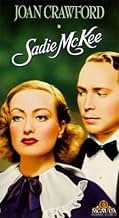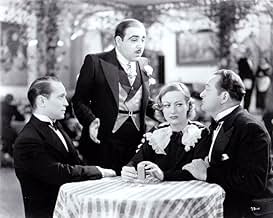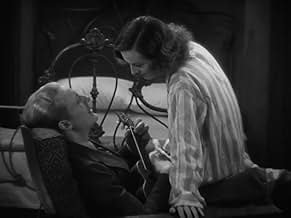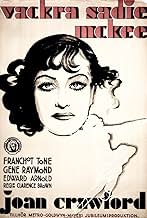VALUTAZIONE IMDb
6,8/10
1805
LA TUA VALUTAZIONE
Aggiungi una trama nella tua linguaA working girl's fortunes improve when she marries into money, but happiness is not so easily won.A working girl's fortunes improve when she marries into money, but happiness is not so easily won.A working girl's fortunes improve when she marries into money, but happiness is not so easily won.
- Regia
- Sceneggiatura
- Star
- Premi
- 3 vittorie totali
Leo G. Carroll
- Phelps
- (as Leo Carroll)
Candy Candido
- Cafe Entertainer
- (as Candy and Coco)
Otto Heimel
- Cafe Entertainer
- (as Candy and Coco)
Norman Ainsley
- Second Butler - at Downstairs Meeting
- (non citato nei titoli originali)
Hooper Atchley
- Intern with Dr. Briggs
- (non citato nei titoli originali)
Nellie Bly Baker
- Downstairs Laundress
- (non citato nei titoli originali)
Jack Baxley
- Short-Order Cook
- (non citato nei titoli originali)
Recensioni in evidenza
"Sadie McKee" was made just before Hollywood got serious about sanitizing its content, and the movie is set squarely in what we now call the pre-Code world. In this world, men are on the make, cops are on the take, rich people do pretty much as they please and prostitution is just another job option.
But while many other pre-Code film can leave you with a bleak feeling about human nature, this one is stocked with basically decent characters. Bribe-takers are just ordinary folks trying to get by. A clever seducer can't silence his own conscience. And when an aging, drunken millionaire orders up a young girl and takes her home for the night, the relationship quickly blossoms from exploitation into an odd kind of love.
Joan Crawford plays the title role, a plucky survivor whose ups and downs would have broken a lesser person. Gene Raymond, Franchot Tone and Edward Arnold play the three very different men in her life. The story is improbable at times, moving from flophouse to sleazy nightclub to mansion. But it's never gets so unrealistic that you stop caring. The ending is somewhat enigmatic, at least to me. I'm still wondering exactly where everyone stood at the end, and where things were headed. That's OK. I like a movie that leaves a little something nagging at you.
If the story is improbable, there's nothing unbelievable about how Joan Crawford's character turns men's heads. A lot of people still view Crawford through a "campy" lens, remembering her long years as a fading star with a lot of personal baggage (real and reputed). Forget all that stuff. In 1934 she was young and lithe and simply gorgeous. She carries this movie, and she carries it well.
But while many other pre-Code film can leave you with a bleak feeling about human nature, this one is stocked with basically decent characters. Bribe-takers are just ordinary folks trying to get by. A clever seducer can't silence his own conscience. And when an aging, drunken millionaire orders up a young girl and takes her home for the night, the relationship quickly blossoms from exploitation into an odd kind of love.
Joan Crawford plays the title role, a plucky survivor whose ups and downs would have broken a lesser person. Gene Raymond, Franchot Tone and Edward Arnold play the three very different men in her life. The story is improbable at times, moving from flophouse to sleazy nightclub to mansion. But it's never gets so unrealistic that you stop caring. The ending is somewhat enigmatic, at least to me. I'm still wondering exactly where everyone stood at the end, and where things were headed. That's OK. I like a movie that leaves a little something nagging at you.
If the story is improbable, there's nothing unbelievable about how Joan Crawford's character turns men's heads. A lot of people still view Crawford through a "campy" lens, remembering her long years as a fading star with a lot of personal baggage (real and reputed). Forget all that stuff. In 1934 she was young and lithe and simply gorgeous. She carries this movie, and she carries it well.
It's easy to see why films like this made Crawford the idol of millions of young women across the country. It's the epitome of a "vehicle".....a film designed to display all the talents of a star and make audiences fall for them. As in many of her early films, she begins at the bottom...the daughter of the cook for a wealthy family including Tone. She gets a hot scene right off the bat when she angrily defends her boyfriend, who is being derided by the aristocrats at the table, by telling them all off (this moment actually brings to mind Emily Watson's similar, yet much more subdued, scene in "Gosford Park".) Soon she and lover Raymond are off to NYC. This section is fascinating as it portrays the way diners were in that era. There's an astonishing coffee dispenser that is shown in one scene and the Automat is quite interesting to behold (not to mention the corned beef hash and 2 poached eggs for $0.35!) Circumstances progress to where she is working in a dance hall (and showing some positively scary legs! It amazing how times have changed in that, today, a similar dancer would have to have sticks for legs and breasts out to there, etc....) Here she becomes associated with a drunken millionaire (Arnold) who takes a major shine to her. Fortunately, for the viewer, she sticks with him, so she can wear an array of dazzling Adrien gowns and furs. Ultimately, each of the men in her life (Tone, Raymond, Arnold) presents her with a variety of conflicts and decisions....all of which she handles with the utmost nobility and grace. She is photographed magnificently throughout with her amazing profile and luminescent eyes featured repeatedly. It's a good thing the film is in black and white because she'd be too much to deal with in color! Everyone knows that Hurrell retouched his amazing portraits of her, but here she looks quite wonderful with just make up and good lighting. The plot is creaky and contrived and the film is just plain out of date, but it's great to see Joan in action in her quintessential role and there's a decent performance from Arnold and nice work by several other supporting players including Hitchcock favorite Carroll. One fun thing to watch for: As a precursor of the later, more antagonistic Crawford, Joan gets fed up with a nightclub singer, barks at her to "Shut up!" and shoves her backwards into a trunk! Fun stuff.
Joan Crawford is "Sadie McKee" in this 1934 film also starring Gene Raymond, Edward Arnold, Franchot Tone, and Jean Dixon.
Crawford is the daughter of the cook for the wealthy Alderson family. The young man of the family, Michael (Tone) has obviously fallen for Sadie, but her heart belongs to loser Tommy Wallace (Raymond), who has just been fired for a malfeasance.
Sadie runs off to New York with Tommy, and the two wind up in the rooming house of Mrs. Craney. The next day, they are to be married at City Hall at noon.
However, showgirl Dolly Merrick (Esther Ralston) who also lives at the rooming house, hears Tommy's dulcet tones and convinces him to forget marriage, leave town, and take a job in her traveling show.
Another women rooming at Mrs. Craney's is Opal, who gets Sadie a job at her club. There Sadie meets the filthy rich, drunken Jack Brennan, whom she marries.
It turns out that Jack's drinking has all but destroyed his health. Though Sadie can't stop thinking about Tommy, she is determined to help Jack quit drinking and regain his health.
Pretty good melodrama, with Crawford wearing some fabulous outfits. Esther Ralston was a gorgeous blonde and is a lively Dolly Merrick, and Jean Dixon gives a good performance as Opal.
The debonair Franchot Tone gives a smooth performance as Michael, and Gene Raymond sings and acts pleasantly enough as Tommy, who manages to be likable though he walked out on Sadie.
Crawford made a lot of this type of film -- the working girl who moves up in class -- and they were very popular. She gives an appealing performance, and she was one actress who could look and act like a hard-working girl who came from a slum and also pull off being glamorous and wealthy.
Worth seeing.
Crawford is the daughter of the cook for the wealthy Alderson family. The young man of the family, Michael (Tone) has obviously fallen for Sadie, but her heart belongs to loser Tommy Wallace (Raymond), who has just been fired for a malfeasance.
Sadie runs off to New York with Tommy, and the two wind up in the rooming house of Mrs. Craney. The next day, they are to be married at City Hall at noon.
However, showgirl Dolly Merrick (Esther Ralston) who also lives at the rooming house, hears Tommy's dulcet tones and convinces him to forget marriage, leave town, and take a job in her traveling show.
Another women rooming at Mrs. Craney's is Opal, who gets Sadie a job at her club. There Sadie meets the filthy rich, drunken Jack Brennan, whom she marries.
It turns out that Jack's drinking has all but destroyed his health. Though Sadie can't stop thinking about Tommy, she is determined to help Jack quit drinking and regain his health.
Pretty good melodrama, with Crawford wearing some fabulous outfits. Esther Ralston was a gorgeous blonde and is a lively Dolly Merrick, and Jean Dixon gives a good performance as Opal.
The debonair Franchot Tone gives a smooth performance as Michael, and Gene Raymond sings and acts pleasantly enough as Tommy, who manages to be likable though he walked out on Sadie.
Crawford made a lot of this type of film -- the working girl who moves up in class -- and they were very popular. She gives an appealing performance, and she was one actress who could look and act like a hard-working girl who came from a slum and also pull off being glamorous and wealthy.
Worth seeing.
Joan Crawford acts up a storm in this well done, interesting soap opera like story of working girl Sadie, daughter of a cook, who is madly in love with a loser named Tommy (played by Gene Raymond). Sadie and Tommy run off together to NYC where they soon take up residence in this shabby, one-room apartment. The next day, big plans for job hunting and a noon appointment at the city hall to get married, but unfortunately for Sadie, Tommy the Rat is thrown in the path of a bad blonde/singer named Dolly who hires him on the spot to sing in her act, they kiss and run off together leaving poor Sadie waiting at the so-called altar. But Sadie pulls herself up by her boot straps, gets a job as a dancer, and meets a multi-millionaire (Edward Arnold) with a big drinking problem, while still holding the torch for her beloved Tommy.
This film is quite a good one, the story completely held my interest, and the acting is top-notch with Joan Crawford giving out her full emotional range, Edward Arnold is excellent playing drunk for the majority of his scenes, and Esther Ralston does a good job as Dolly, the loose hipped, barely able to sing man-snatcher. Franchot Tone plays a lawyer, the son of the well-to-do home where Sadie was raised - he isn't given as much to do here as I would have liked but still gives a satisfying performance, and he certainly looks handsome enough, as usual. The film includes a few fun to watch musical numbers, plus some interesting scenes filmed in diners and a neat old-time Automat.
This film is quite a good one, the story completely held my interest, and the acting is top-notch with Joan Crawford giving out her full emotional range, Edward Arnold is excellent playing drunk for the majority of his scenes, and Esther Ralston does a good job as Dolly, the loose hipped, barely able to sing man-snatcher. Franchot Tone plays a lawyer, the son of the well-to-do home where Sadie was raised - he isn't given as much to do here as I would have liked but still gives a satisfying performance, and he certainly looks handsome enough, as usual. The film includes a few fun to watch musical numbers, plus some interesting scenes filmed in diners and a neat old-time Automat.
I'm a big fan of the Crawford oeuvre, in all its permutations and occasional excesses. That said, her Sadie is refreshingly underplayed and sincere. The mid-Atlantic accent that she tended to is at a minimum here, and there is a fluidity that is in much contrast to the Greek tragic masks, riveting though they are, of some of her later performances. The wonderful Jean Dixon is on hand in a role that is a precursor to Eve Arden's pal of "Mildred Pierce" and "Goodbye My Fancy"--worldly, rueful, self-denigrating. (Mary Phillips took on a similar part in "The Bride Wore Red" several years later.) Esther Ralston does a fine job as the blowsy, sensuous man-stealer--at one point she practically does a Mae West with her intonations and stance. Solid performances also from Franchot Tone and Gene Raymond and the always-reliable, under-appreciated Edward Arnold. The very engaging Earl Oxford appears as "the Stooge" and one wonders why this charmer did not have a film career.
The story is serviceable, and there is a motif of characters' taking responsibility for their lives, and, as best they can, making amends for wrongs. Note that at the start and end of the film there are scenes in which the camera follows a character from one room to the next in such a way that you realize that there is not any real partition between the two rooms--an enjoyable little breaking of the "fourth wall" premise of theater.
The story is serviceable, and there is a motif of characters' taking responsibility for their lives, and, as best they can, making amends for wrongs. Note that at the start and end of the film there are scenes in which the camera follows a character from one room to the next in such a way that you realize that there is not any real partition between the two rooms--an enjoyable little breaking of the "fourth wall" premise of theater.
Lo sapevi?
- QuizOne of the first films to treat alcoholism as a serious problem, instead of a comic device.
- BlooperWhen Tommy is in his hospital room he makes Dr. Briggs promise not to tell Sadie of his condition. However, when Dr. Briggs leaves the room, Sadie is there with the other doctors and she already knows. Dr. Briggs then says, "He made me promise he wouldn't tell her." This dialogue obviously makes no sense and is wrong. What he meant to say was, "He made me promise not to tell her."
- Citazioni
Sadie McKee Brennan: [showing off her bedroom] Here it is.
Opal: Lady, when you say, "I do take thee," how you take him.
Sadie McKee Brennan: [chuckles]
Opal: Got this all to yourself?
Sadie McKee Brennan: Yep, all to myself.
Opal: Always all to yourself?
Sadie McKee Brennan: Yep.
Opal: Well, a whole lot of us do a whole lot more for a whole lot less.
- ConnessioniFeatured in Che fine ha fatto Baby Jane? (1962)
- Colonne sonoreAll I Do Is Dream Of You
(1934) (uncredited)
Music by Nacio Herb Brown
Lyrics by Arthur Freed
Played during the opening credits
Sung by Gene Raymond three times
Sung also by Earl Oxford in a show
I più visti
Accedi per valutare e creare un elenco di titoli salvati per ottenere consigli personalizzati
- How long is Sadie McKee?Powered by Alexa
Dettagli
Botteghino
- Budget
- 612.000 USD (previsto)
- Tempo di esecuzione
- 1h 33min(93 min)
- Colore
- Proporzioni
- 1.37 : 1
Contribuisci a questa pagina
Suggerisci una modifica o aggiungi i contenuti mancanti























